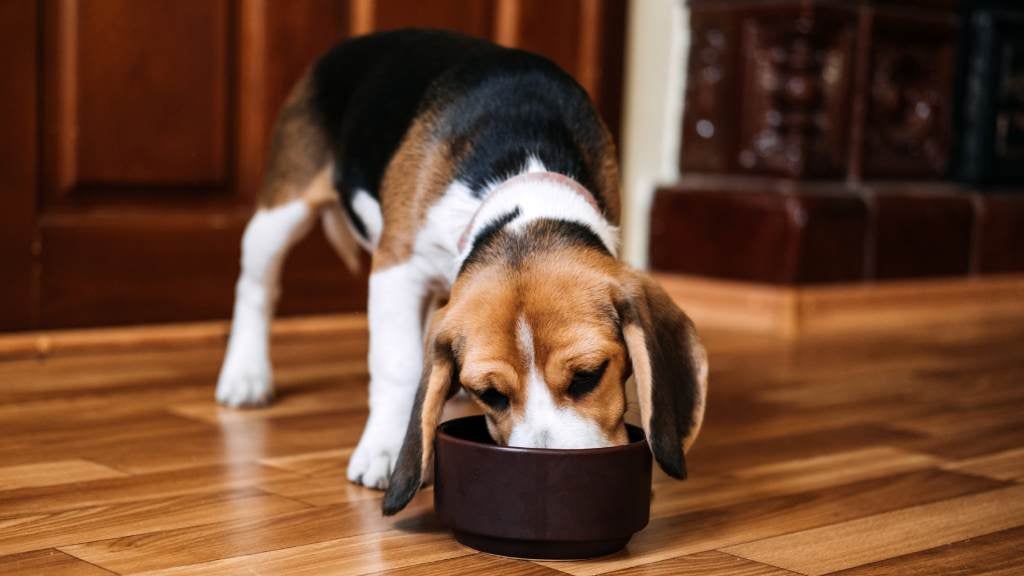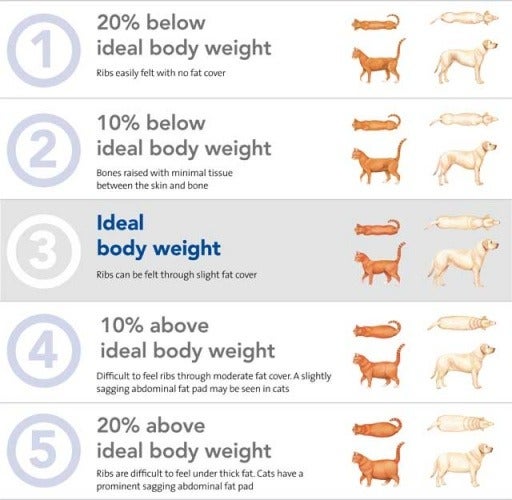Food in relation to your dog’s age
This is the age when many pups will enter their new home. It’s important to not make huge diet changes at this time as you might inadvertently cause a stomach upset.
Many breeders will tell you what they have been feeding your dog. Ideally, you will continue with this, and introduce the diet you wish to feed them in small incremental stages over a few weeks until you are feeding your pup your preferred diet completely.
The best food to feed is a high quality commercial kibble designed for puppies. This ensures all the nutrients your puppy needs for growth and development are present.
You can add cooked meats and vegetables or rice as you wish; however, the main diet needs to be the commercially balanced kibble.
Raw diets are not recommended for very young pups as they don’t have the immune system development to cope with a high bacterial load. It is also very difficult to balance a raw diet for growing puppies.
Puppies have a high nutritional demand and can’t go for long without food. It’s very important to feed small meals regularly.

At the 16-week mark, feel free to introduce some raw meaty bones gradually. It’s around this time that permanent teeth are erupting, so this encourages them to chew actively on something other than your shoes or couch (it won’t affect or benefit teeth health at all). For puppies, one bone a week is generally enough; and remember, the meatier – the better.
Don’t be alarmed if your puppy becomes possessive over its food when it’s eating. Always discourage children from getting too close to them when they’re eating, and be aware they may growl or snap at you if you attempt to take the food away. You can prevent the development of food guarding by handfeeding your pup in the early stages. If your pup already guards, please seek help from a veterinarian.
When you’re introducing a new food to your pup, keep an eye on it at all times for any signs of illness or distress. Like humans, dogs can have intolerances or be allergic to things, or a certain food simply may not agree with your pup. Note down what it is you fed your puppy if a reaction or illness occurs and pop that on the no-feed list.
As your pup gets older, you can gradually reduce the number of feeds to twice per day. Try to ensure you aren’t overfeeding or underfeeding your dog. It can be tricky as most people will assume bigger breeds need more to eat; however, this isn’t always the case. Overfeeding your puppy can lead to health issues such as musculoskeletal problems later in its life.
Adult dogs should be fed either once or twice a day. Use a high-quality commercial dog food, making sure it’s appropriate for the life stage and health status of your dog.
Small or medium breed dogs are generally deemed to be ’adults’ from 12 months of age, whereas your larger breed dogs take a little longer and don’t really become ‘adults’ until 18–24 months.
Check with your veterinarian when to change over from puppy-appropriate food to adult-appropriate food.
The same feeding guidelines apply to adult dogs. Ensure the diet you choose is complete and balanced. You can add meat (cooked or raw), and vegetables or fish for variety. Choose large, raw, meaty bones. Most importantly, don’t over feed.
For senior dogs, the need to keep tabs on their health is crucial. Many older dogs have chronic health issues that can be affected or improved by the diet you feed.
For some senior dogs, frequent smaller meals will keep them happy and satisfied. For others, it’s about keeping things the same as before. Some senior dogs may need more fibre, protein or other nutrients to ensure their bodies are taken care of. Speak to your veterinarian about your dog’s specific needs.
How much food your dog needs
The amount of food your dog needs will largely depend on the size, breed and age of your dog, as well as how regularly it exercises. The key is to ensure you don’t overfeed or underfeed your dog. If ever you’re unsure, ask your vet to assess your dog’s diet and nutrition, and the condition of its body and overall health.
Always ensure your dog is well hydrated. This means making sure their water bowl is filled up at all times and is changed daily, so they can help themselves to water whenever they need or want.
When assessing your dog’s size and weight, it is far more important to look at their body shape than weight. You want your dog to be lean, which means you should be able to feel their ribs when you run your fingers firmly over their side and see a defined waist. If this isn’t possible, it’s diet time. Obesity in dogs is linked to decreased longevity and diseases such as osteoarthritis, and it is totally preventable.

supplied by Hill’s Prescription Diet ~ Clinical Nutrition to Improve Quality of Life
They Look Great But Are Always Hungry
Using the guidelines on a commercial pet food label should be a starting point for deciding how much to feed your dog. If they seem hungry all the time, you may need to feed them more. Beware that some dogs will always seem hungry and are already overweight. You may need to use a diet food that is more filling to them.
The amount of food your dog needs may change if:
Before giving them more food, make sure they are not just looking for attention and love. And if they are, serve that up instead.
HOW TO FEED A DOG OR PUPPY CORRECTLY How many times a day you should feed your dog
As dog owners, we are often confronted with the question, what is the best time to feed our dogs? Is it better to feed a dog before or after exercise? Or is it a completely different part of the day?
While there is no right answer to best time to feed a dog, we can simplify the affair if we approach the task keeping the following points in mind.